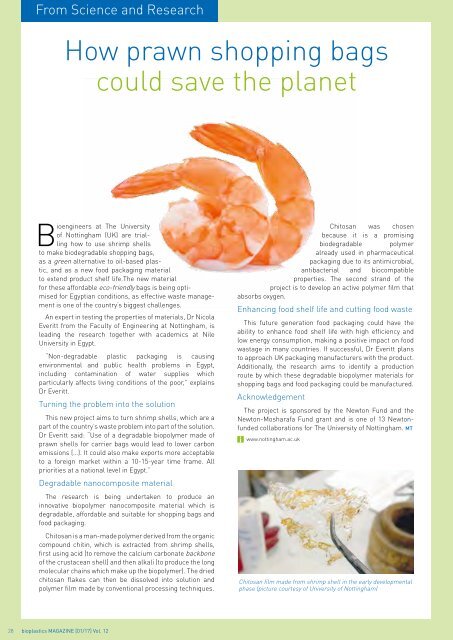Issue 01/2017
bioplasticsMAGAZINE_1701
bioplasticsMAGAZINE_1701
You also want an ePaper? Increase the reach of your titles
YUMPU automatically turns print PDFs into web optimized ePapers that Google loves.
From Materials Science and Research<br />
How prawn shopping bags<br />
could save the planet<br />
Bioengineers at The University<br />
of Nottingham (UK) are trialling<br />
how to use shrimp shells<br />
to make biodegradable shopping bags,<br />
as a green alternative to oil-based plastic,<br />
and as a new food packaging material<br />
to extend product shelf life.The new material<br />
for these affordable eco-friendly bags is being optimised<br />
for Egyptian conditions, as effective waste management<br />
is one of the country’s biggest challenges.<br />
An expert in testing the properties of materials, Dr Nicola<br />
Everitt from the Faculty of Engineering at Nottingham, is<br />
leading the research together with academics at Nile<br />
University in Egypt.<br />
“Non-degradable plastic packaging is causing<br />
environmental and public health problems in Egypt,<br />
including contamination of water supplies which<br />
particularly affects living conditions of the poor,” explains<br />
Dr Everitt.<br />
Turning the problem into the solution<br />
This new project aims to turn shrimp shells, which are a<br />
part of the country’s waste problem into part of the solution.<br />
Dr Everitt said: “Use of a degradable biopolymer made of<br />
prawn shells for carrier bags would lead to lower carbon<br />
emissions (…). It could also make exports more acceptable<br />
to a foreign market within a 10-15-year time frame. All<br />
priorities at a national level in Egypt.”<br />
Degradable nanocomposite material<br />
The research is being undertaken to produce an<br />
innovative biopolymer nanocomposite material which is<br />
degradable, affordable and suitable for shopping bags and<br />
food packaging.<br />
Chitosan is a man-made polymer derived from the organic<br />
compound chitin, which is extracted from shrimp shells,<br />
first using acid (to remove the calcium carbonate backbone<br />
of the crustacean shell) and then alkali (to produce the long<br />
molecular chains which make up the biopolymer). The dried<br />
chitosan flakes can then be dissolved into solution and<br />
polymer film made by conventional processing techniques.<br />
Chitosan was chosen<br />
because it is a promising<br />
biodegradable polymer<br />
already used in pharmaceutical<br />
packaging due to its antimicrobial,<br />
antibacterial and biocompatible<br />
properties. The second strand of the<br />
project is to develop an active polymer film that<br />
absorbs oxygen.<br />
Enhancing food shelf life and cutting food waste<br />
This future generation food packaging could have the<br />
ability to enhance food shelf life with high efficiency and<br />
low energy consumption, making a positive impact on food<br />
wastage in many countries. If successful, Dr Everitt plans<br />
to approach UK packaging manufacturers with the product.<br />
Additionally, the research aims to identify a production<br />
route by which these degradable biopolymer materials for<br />
shopping bags and food packaging could be manufactured.<br />
Acknowledgement<br />
The project is sponsored by the Newton Fund and the<br />
Newton-Mosharafa Fund grant and is one of 13 Newtonfunded<br />
collaborations for The University of Nottingham. MT<br />
www.nottingham.ac.uk<br />
Chitosan film made from shrimp shell in the early developmental<br />
phase (picture courtesy of University of Nottingham)<br />
28 bioplastics MAGAZINE [<strong>01</strong>/17] Vol. 12


















